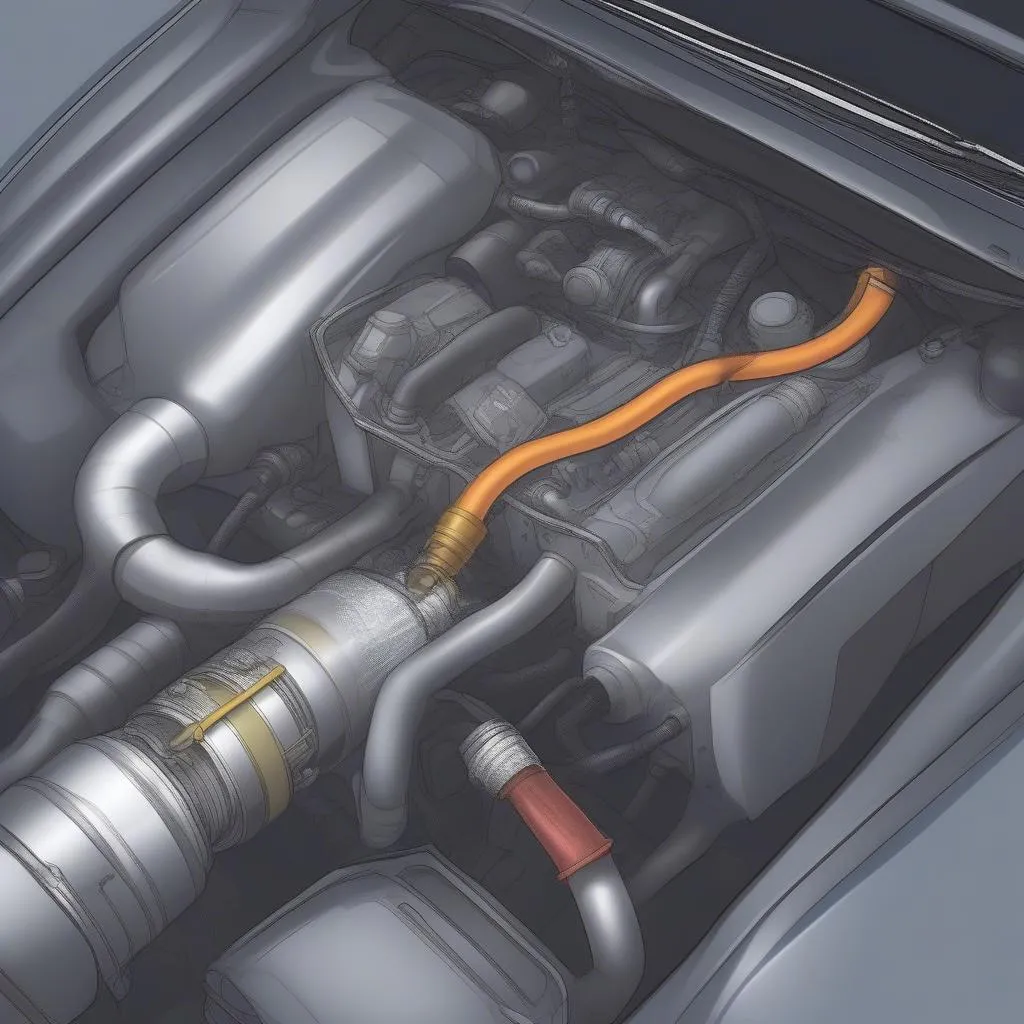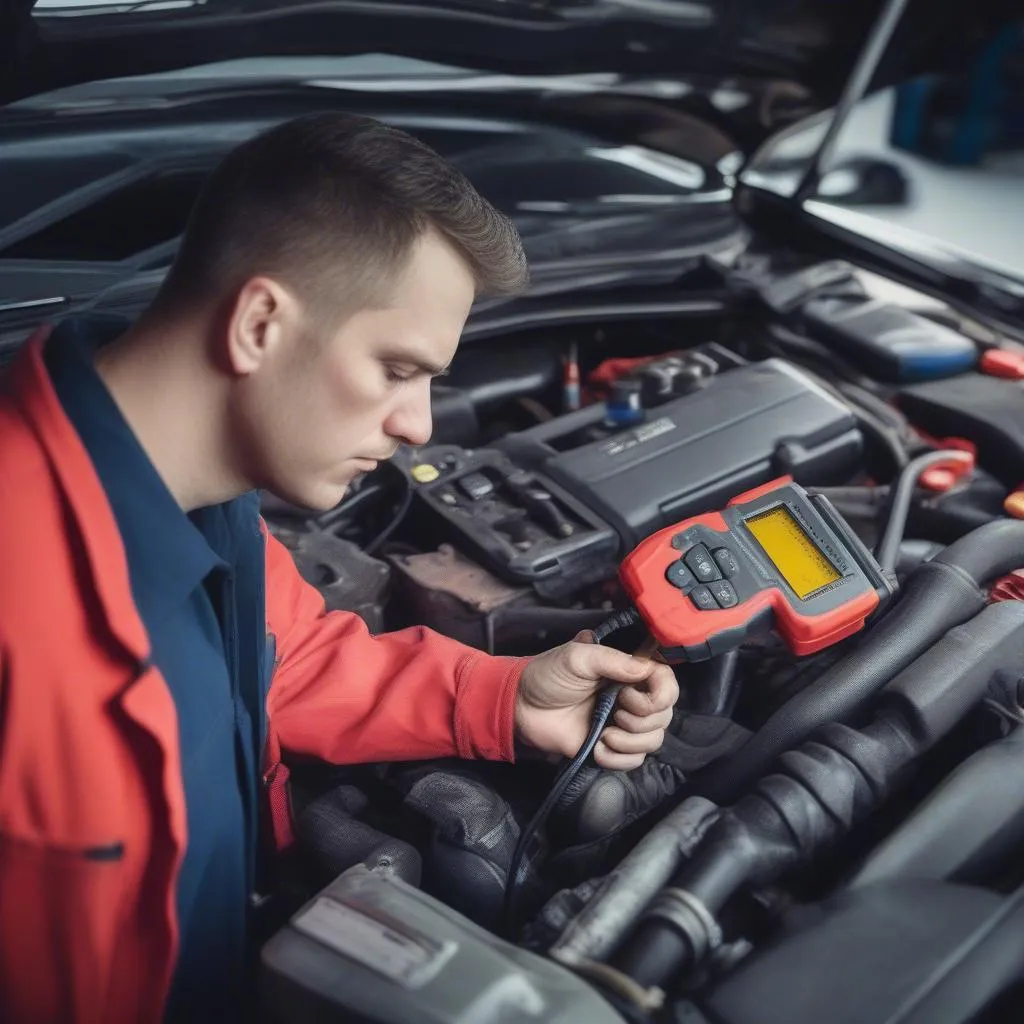“A smooth sea never made a skilled sailor,” or so the saying goes. Similarly, owning a car means occasionally encountering a few bumps in the road. One of these bumps often comes in the form of a mysterious “check engine” light flashing on your dashboard, leaving you feeling anxious and unsure of what’s wrong with your beloved vehicle.
There’s no need to panic! Often, these warning lights are triggered by OBD codes, which act as your car’s internal communication system, signaling specific issues within the engine. Today, we’ll delve into the intricate world of Obd Code P1130, a common concern for many car owners, especially those driving European makes. We’ll decipher its meaning, explore its implications, and empower you with the knowledge to address it effectively.
Decoding the Enigma: What Does Obd Code P1130 Mean?
In essence, OBD code P1130 points towards a problem with your car’s air/fuel ratio, specifically in Bank 1 Sensor 1. Let’s break this down further:
- OBD Code: Stands for On-Board Diagnostics, a standardized system in modern vehicles that monitors emissions and engine performance.
- P1130: This specific code indicates an issue with the oxygen sensor (O2 sensor) or its circuit.
- Bank 1: Refers to the side of the engine containing cylinder #1.
- Sensor 1: Indicates the upstream oxygen sensor, located before the catalytic converter.
In simpler terms, code P1130 suggests that the upstream oxygen sensor on the side of the engine with cylinder #1 is not providing the correct data to the Engine Control Unit (ECU). This sensor plays a crucial role in helping the ECU determine the optimal air/fuel mixture for efficient combustion. A malfunctioning sensor can lead to a range of performance issues.
Symptoms of Obd Code P1130: Identifying the Warning Signs
Imagine driving down the highway, and your car suddenly starts to sputter, losing power as you press the accelerator. This scenario, unfortunately, could be a sign of OBD code P1130 rearing its head. Recognizing the symptoms can help you address the issue promptly:
- Illuminated Check Engine Light: This is often the first and most obvious sign.
- Rough Idling: The engine might vibrate excessively or sound uneven while the car is stationary.
- Reduced Fuel Economy: A noticeable drop in your miles per gallon could indicate an incorrect air/fuel mixture.
- Hesitation or Stalling: The engine might struggle to respond to acceleration or even stall unexpectedly.
- Increased Emissions: Your car’s exhaust might produce black smoke or a strong fuel odor.
 Oxygen Sensor Illustration
Oxygen Sensor Illustration
Unraveling the Causes: Why Does Obd Code P1130 Occur?
Just like a detective investigates a crime scene, a mechanic approaches a car problem with a keen eye for detail. Several potential culprits can trigger OBD code P1130:
- Faulty Oxygen Sensor (Bank 1, Sensor 1): The most common culprit, oxygen sensors have a limited lifespan and can wear out over time.
- Vacuum Leaks: Any leaks in the intake manifold or vacuum hoses can disrupt air/fuel ratio readings.
- Fuel System Issues: Problems with the fuel pump, fuel injectors, or fuel pressure regulator can affect the fuel delivery.
- Exhaust Leaks: Leaks in the exhaust manifold or pipes before the oxygen sensor can alter exhaust gas readings.
- Wiring Problems: Damaged or corroded wiring to the oxygen sensor can disrupt the signal transmission.
Navigating the Fix: Resolving Obd Code P1130
Addressing OBD code P1130 doesn’t have to feel like navigating a labyrinth. Here’s a step-by-step guide to tackle the issue:
- Diagnose the Code: Start by confirming the code using an OBD-II scanner.
- Inspect the Oxygen Sensor: Visually examine the sensor for any visible damage, looseness, or contamination.
- Check for Vacuum Leaks: Inspect all vacuum hoses and the intake manifold for any signs of leaks.
- Test the Fuel System: Ensure proper fuel pressure and injector operation.
- Inspect the Exhaust System: Look for any leaks in the exhaust manifold or pipes.
- Check Wiring and Connections: Examine the wiring harness for damage or corrosion.
Once you’ve identified the root cause, replacing the faulty component or repairing the issue is usually the solution.
 Mechanic Inspecting Car
Mechanic Inspecting Car
Preventative Measures: Keeping Obd Code P1130 at Bay
“An ounce of prevention is worth a pound of cure,” as the adage goes. The same principle applies to car maintenance. Here are some proactive steps to prevent OBD code P1130 from recurring:
- Regular Maintenance: Adhere to your car’s recommended maintenance schedule, including regular oil changes, air filter replacements, and spark plug checks.
- Use Quality Fuel: Opt for high-quality fuel from reputable gas stations to minimize fuel system contamination.
- Address Issues Promptly: Don’t ignore any warning signs or unusual car behavior. Address them promptly to prevent minor problems from escalating.
Beyond P1130: Exploring Similar OBD Codes
The world of OBD codes can seem like a complex tapestry, with numerous codes interconnected and often appearing together. Understanding these related codes can provide a more comprehensive view of your car’s health. Some codes similar to P1130 include:
- OBD Code P1133: Indicates a slow response time from the same oxygen sensor as P1130.
- OBD Code P1135: Signals a malfunctioning heater circuit in the Bank 1, Sensor 1 oxygen sensor.
- OBD Code P1150: This code, often occurring alongside P1130, points to a fault in the air/fuel ratio sensor circuit for Bank 2, Sensor 1.
From Codes to Confidence: Taking Charge of Your Car’s Health
Navigating the world of OBD codes might initially seem daunting, but remember, knowledge is power. By understanding what these codes mean and how to address them, you’re one step closer to becoming a more informed and empowered car owner.
Remember, while this guide offers a comprehensive overview of OBD code P1130, it’s always best to consult with a qualified mechanic for a proper diagnosis and repair. They have the expertise and specialized tools to pinpoint the exact issue and ensure your car receives the best care.
Need help deciphering those confusing diagnostic codes or troubleshooting car issues? Contact us on Whatsapp at +84767531508 for expert assistance and 24/7 support. We’re here to help you get back on the road with confidence.
Looking for more insights on specific car models and OBD codes? Check out these related articles on our website:
- 2000 Toyota Avalon OBD Codes 1130, 1133, 1135
- OBD Code P1133: What Does It Mean and How to Fix It
- Understanding OBD Code P1135 in Your 2001 Camry